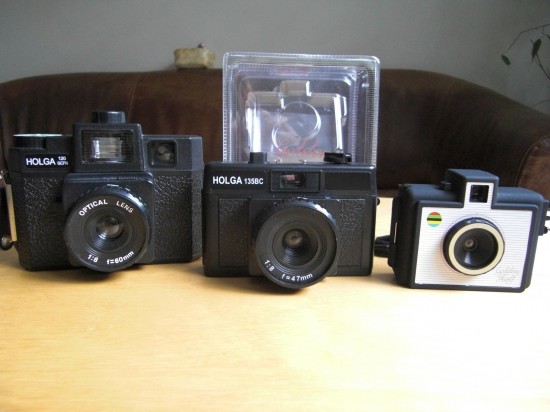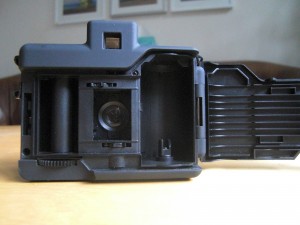At the same time, it’s tiny compared to other film cameras. Imagine a stack of 5 Mini Discs maybe… or to say it with numbers, 9.5 x 7 x 3.5cm (that’s 3.5 x 2.5 x 1 inch) at only 84 grams not including a film (which would weigh about 20 grams). It fits neatly in the palm of my hand.
Apart from the obvious shutter button next to the viewfinder (top middle), the camera features an accurate film counter which counts all the way over 72. That’s a magical sight on a film camera, especially when you’re used to changing a roll every 12 pictures. It’s got a loupe to magnify the tiny numbers on what must be a white plastic wheel on the inside.
The film is wound to the next exposure with a plastic cog wheel, like we know and love from disposable cameras. You open the camera with a switch on the left, and there’s a little plastic crank on the bottom to rewind the film. All in all, it’s got a pretty sturdy feel to it.

On the front we find a switch for two real apertures: f8 for cloudy and f11 for sunny days (give or take 5% says the manual). I say “real apertures” here because you can actually see the hole changing, unlike on Holga cameras, where the aperture switch doesn’t work out of the box. There’s a third setting here with a flash symbol, which switches to f11 again – bringing us to yet another exciting feature: the Flash Hotshoe.
Even though it’s positioned a bit odd at the top left hand side of the camera, the Golden Half features a proud hotshoe for an external flashgun! I’ve tested this with a Canon 580 EX-II speedlite, and it works a treat. The flash fires in any of the three aperture positions, no matter if you choose flash, cloudy or sunny. Sweet!
To round it all off, there’s a tripod mount on the bottom of the camera. This might come in handy not so much for actual tripod shots, but more for accessory attachments. Sadly, there’s no bulb feature – but hey, when have I used that last?
Under the Hood
Let’s take a look at the insides of this little plastic gem.

What strikes me at first glance is that the film winds from right to left, not from left to right as is usually the case. It certainly doesn’t matter, but it’s a fact I’ve never thought about. All cameras I’ve worked with wound the other way round. Interesting.
You don’t have to lift the crank on the bottom, the film canister just fits in without mechanical shenanigans. The take-up spook is fairly thick, which is nice for the film. There’s a slit in the spool into which you can insert the film, which makes loading the camera very easy.
The bottom sprocket is used to crank up the leaf shutter, which must be a very thin plastic plate. The manual states that it fires at 1/100th of a second. There’s a thin clear plastic sheet in front of the shutter, possibly for protection. No pressure plate, just simple grooves to hold the film in place.
As for the lens, it certainly looks like it’s made from pure plastic. I’ve just seen some scanned results, and it looks like at f8 there’s a good sweet spot of about 50% in the middle, with fairly blurred edges (depending on the shot). Reminds me of the Holga look through and through. I’m sure at f11 we’d see more of the sweet spot, and a less blurred edge.
Let’s see some pictures
I’ve had the privilege of shooting about four rolls with the Golden Half already, and I’m impressed! Just what I was hoping for, especially when it comes to black and white.
hi, do you turn the knob until it stops each time you press the shutter? or you press the shutter 2 times for double frames and then turn the knob? Thank you
It’s been a while since I’ve handled my Golden Half, but from what I remember the film transport and shutter are not connected. You can press the shutter as many times as you like, which creates an exposure every time you click. So for two exposures, wins the film, the press the shutter twice (or more time). Hope this helps!